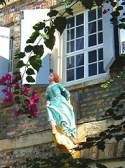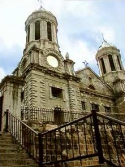|
|
|
|
|
|
Beaches
|
|
Northwest Coast:
|
|
 Dickenson Bay and Runaway Bay, located along the island's developed northwestern coast, are the place to go for those who want the fully-loaded resort beach experience. The beaches most
convenient to St. John's are Fort James, a locally-popular public beach, and Deep Bay. Galley Bay attracts surfers during the winter months and a joggers during the evening. The series of four
crescent beaches at Hawksbill are also highly regarded, one of which is nudist. Dickenson Bay and Runaway Bay, located along the island's developed northwestern coast, are the place to go for those who want the fully-loaded resort beach experience. The beaches most
convenient to St. John's are Fort James, a locally-popular public beach, and Deep Bay. Galley Bay attracts surfers during the winter months and a joggers during the evening. The series of four
crescent beaches at Hawksbill are also highly regarded, one of which is nudist.
|
|
|
|
Southwest and South Coast:
|
|
The beaches of the hilly southwest corner of Antigua are generally less developed than those around St. John's further north. On the road
that winds along this coast are Fryes Bay, Darkwood Beach, and the beaches around Johnsons Point. Rendezvous Bay and especially Doigs Beach, both located on the central southern coast at Rendezvous Bay, are
especially quiet beaches worth the rough travel necessary to reach them. Pigeon Point, near English Harbour Town, is a convenient balm after a day at Nelson's Dockyard.
|
|
|
|
East Coast:
|
|
On the southeast corner of the island is Half Moon Bay, now a National Park and a good choice for a family outing. Long Bay, on the
easternmost point of the island, is another good choice for families, as it is completely protected by its reef.
|
|
|
|
English Harbour
|
|
English Harbour, Antigua's graceful and evocative historic district, is focused on the fifteen  square miles of Nelson's Dockyard National Park. Developed as a
base for the British Navy in the great age of sail, the harbour served as the headquarters of the fleet of the Leeward Islands during the turbulent years of the late 18th century. Although the dockyard was
greatly expanded at that time by Horatio Nelson, it was gradually abandoned in the nineteenth century and was closed in 1889. Today Nelson's Dockyard has been completely restored, and it is
now the only Georgian dockyard in the world. square miles of Nelson's Dockyard National Park. Developed as a
base for the British Navy in the great age of sail, the harbour served as the headquarters of the fleet of the Leeward Islands during the turbulent years of the late 18th century. Although the dockyard was
greatly expanded at that time by Horatio Nelson, it was gradually abandoned in the nineteenth century and was closed in 1889. Today Nelson's Dockyard has been completely restored, and it is
now the only Georgian dockyard in the world.
Almost all of the park's other sites of interest overlook the harbour. The closest of these is Clarence House, a residence built for the
future King William IV (1765-1837) when he served under Nelson as captain of the H.M.S. Pegasus. Further above the harbour, at Shirley Heights, are the partially-restored
fortifications of the harbour's colonial observation post; the view from Shirley Heights extends out over the harbour and far across the Caribbean to Montserrat and Guadaloupe.
On Sundays the vista is enhanced by barbeque and live music at the bar there (Steel Band music from 3-6 pm & reggae from 6-9). Shirley Heights can be reached via Lookout Trail, a
nature walk that rises from the harbour through a forest of trees--descending the trail is not advisable after dark or barbecue revelry.
 Along Lookout Trail and near Shirley Heights is Dow's Hill Interpretation Center, at which visitors can watch an impressive multimedia presentation of Antigua's history, from its initial
settlement to independence. Observation decks at Dow's Hill provide another fine view of the harbour, as do the ruined fortifications of Fort Berkeley, located on the far side of the bay and
reached by a walk around its perimeter. All of these points, as well as the park's convenient beaches, become especially popular spectator positions during Sailing Week. Along Lookout Trail and near Shirley Heights is Dow's Hill Interpretation Center, at which visitors can watch an impressive multimedia presentation of Antigua's history, from its initial
settlement to independence. Observation decks at Dow's Hill provide another fine view of the harbour, as do the ruined fortifications of Fort Berkeley, located on the far side of the bay and
reached by a walk around its perimeter. All of these points, as well as the park's convenient beaches, become especially popular spectator positions during Sailing Week.
|
|
St. John's
|
|
The skyline of St. John's, the capital and largest city of Antigua and Barbuda, is dominated  by the magnificently evocative white baroque towers of St. John's
Cathedral. Built in 1845, the church is now in its third incarnation, as earthquakes in 1683 and in 1745 destroyed the previous structures. The towers are the first sight of Antigua for about half of
the island's visitors each year, many of whom arrive by boat. With its recently completed cruise ship dock and several hotels, St. John's is a lively hub for shopping and dining. by the magnificently evocative white baroque towers of St. John's
Cathedral. Built in 1845, the church is now in its third incarnation, as earthquakes in 1683 and in 1745 destroyed the previous structures. The towers are the first sight of Antigua for about half of
the island's visitors each year, many of whom arrive by boat. With its recently completed cruise ship dock and several hotels, St. John's is a lively hub for shopping and dining.
For those interested in the early history of the island, there is the Museum of Antigua and Barbuda, housed in the colonial Court
House (1750). The museum displays both Arawak and colonial artifacts recovered on archaeological digs on the islands. It also features a
thought-provoking, life-size replica of an Arawak house, models of sugar plantations, etc.
On Friday and Saturday mornings, be sure to visit the vibrant farmers market on the
southern edge of the city. Folk crafts, colorful tropical fruits, and a buzzing crowd make for a lively morning.
|
|
Diving
|
|
Both Antigua and Barbuda are almost completely surrounded by well-preserved coral reefs, walls, and shipwrecks. The southern and eastern
coasts of Antigua and virtually the entire coast of Barbuda are surrounded by shelfs, providing excellent conditions for spectacular shallow diving and snorkeling. There is little or no current in most places, and
the water  temperature averages about 80 F (25 C). Underwater visibility
ranges from 50 to 140 feet, and tropical marine plants and animals are diverse and plentiful. Snorkeling is possible at many of both islands' most beautiful beaches; one of Antigua's best-known
offshore sites, Cades Reef, is now partly contained in a designated underwater park. Another popular destination is the wreck of the
Andes, a three-masted merchant ship that sank in 1905 and now rests in less than thirty feet of water in (ironically enough) Deep Bay. Antigua's dive facilities are far superior to
those available on smaller Barbuda, and so most of the sites that have been established as dive destinations are Antiguan. The southern and eastern coasts are considered to offer the
most consistent diving; for more advanced divers, the ledge of Sunken Rock on the south coast is a popular site. Dive depths generally range from 25 to 80 feet and can reach 180
feet; distances from shore to site are in some cases no more than five minutes and at most 40 minutes away. temperature averages about 80 F (25 C). Underwater visibility
ranges from 50 to 140 feet, and tropical marine plants and animals are diverse and plentiful. Snorkeling is possible at many of both islands' most beautiful beaches; one of Antigua's best-known
offshore sites, Cades Reef, is now partly contained in a designated underwater park. Another popular destination is the wreck of the
Andes, a three-masted merchant ship that sank in 1905 and now rests in less than thirty feet of water in (ironically enough) Deep Bay. Antigua's dive facilities are far superior to
those available on smaller Barbuda, and so most of the sites that have been established as dive destinations are Antiguan. The southern and eastern coasts are considered to offer the
most consistent diving; for more advanced divers, the ledge of Sunken Rock on the south coast is a popular site. Dive depths generally range from 25 to 80 feet and can reach 180
feet; distances from shore to site are in some cases no more than five minutes and at most 40 minutes away.
Barbuda's encircling reefs contain an enormous number of wrecks, most of which are yet to
be explored; in fact, the Codrington fortunes on Barbuda were intimately linked to their acquisition of rights to the wreckage in the 17th-century. To dive off Barbuda, it is best to
make arrangements with a dive shop on Antigua to have the necessary equipment taken over by air or boat.
|
|
Sea View Farm Village
|
|
Antiguan folk pottery dates back at least to the early 18th century, when slaves fashioned  cooking vessels from local clay. Today, folk pottery is fashioned in
a number of places around Antigua, but the center of this cottage industry is Sea View Farm Village. The clay is collected from pits located nearby, and the wares are fired in an open fire under layers
of green grass in the yards of the potters' houses. Folk pottery can be purchased at outlets in the village as well as at a number of stores around the island.
Buyers should be aware that Antiguan folk pottery breaks rather easily in cold environments. cooking vessels from local clay. Today, folk pottery is fashioned in
a number of places around Antigua, but the center of this cottage industry is Sea View Farm Village. The clay is collected from pits located nearby, and the wares are fired in an open fire under layers
of green grass in the yards of the potters' houses. Folk pottery can be purchased at outlets in the village as well as at a number of stores around the island.
Buyers should be aware that Antiguan folk pottery breaks rather easily in cold environments.
|
|
Harmony Hall Art Gallery
|
|
 Harmony Hall, in Brown's Bay at Nonsuch Bay, is the center of the Antiguan arts community. Exhibits change throughout the year, but
the annual highlights are the Antigua Artist's Exhibition and the Harmony Hall, in Brown's Bay at Nonsuch Bay, is the center of the Antiguan arts community. Exhibits change throughout the year, but
the annual highlights are the Antigua Artist's Exhibition and the  Craft Fair, both in November. The sugar mill tower around which Harmony Hall is built has been converted to a bar and provides its
patrons with one of the island's best panoramic views, including a fine prospect of Nonsuch Bay. Craft Fair, both in November. The sugar mill tower around which Harmony Hall is built has been converted to a bar and provides its
patrons with one of the island's best panoramic views, including a fine prospect of Nonsuch Bay.
|
|
|